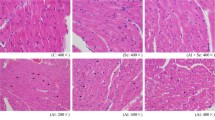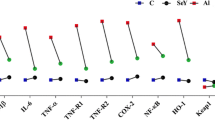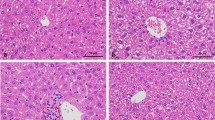Abstract
High Selenium Yeast (SeY) serves many important roles with respect to the maintenance of normal nervous system functioning. Studies have reported the nerve inflammation induced by Aluminum (Al) was associated with the increase of mortality. However, in-depth studies are required to verify the hypothesized neuro-protective efficacy of SeY against Al-induced cerebral damage through modulation of the inflammatory response. Here, mice were treated with SeY (0.1 mg/kg) and/or Al (10 mg/kg) by oral gavage for 28 days. Inflammation was assessed by histopathological examination and expression of biomarkers for inflammation. Furthermore, the oxidation–reduction levels and the NO production were assessed using diagnostic kits and RT-PCR. The data indicated that SeY significantly protected cerebrum against Al-induced pathological changes, in addition to the disordered expression of biomarkers of inflammation, the imbalance of oxidation–reduction, and the increase of NO production. Therefore, the chemoprotective potential of SeY against Al-induced cerebral inflammation via restore the levels of oxidation–reduction and the generation of NO was demonstrated.




Similar content being viewed by others
References
Angstwurm MW et al (2007) Selenium in Intensive Care (SIC): results of a prospective randomized, placebo-controlled, multiple-center study in patients with severe systemic inflammatory response syndrome, sepsis, and septic shock. Crit Care Med 35:118
Ansar S (2016) Effect of selenium on the levels of cytokines and trace elements in toxin-mediated oxidative stress in male rats. Biol Trace Elem Res 169:129–133
Cao C et al (2017) Inflammatory response occurs in veins of broiler chickens treated with a selenium deficiency diet. Biol Trace Elem Res 173:1–9
Chen X, Yao H, Yao L, Zhao J, Luan Y, Zhang Z, Xu S (2014) Selenium deficiency influences the gene expressions of heat shock proteins and nitric oxide levels in neutrophils of broilers. Biol Trace Elem Res 161:334–340
Codoñer-Franch P, Tavárez-Alonso S, Murria-Estal R, Megías-Vericat J, Tortajada-Girbés M, Alonso-Iglesias E (2011) Nitric oxide production is increased in severely obese children and related to markers of oxidative stress and inflammation. Atherosclerosis 215:475–480
Colombo E et al (2012) Stimulation of the neurotrophin receptor TrkB on astrocytes drives nitric oxide production and neurodegeneration. J Exp Med 209:521
Darbre PD, Mannello F, Exley C (2013) Aluminium and breast cancer: sources of exposure, tissue measurements and mechanisms of toxicological actions on breast biology. J Inorg Biochem 128:257–261
Ding R, Yang Y (2010) Aluminum chloride induced oxidative damage on cells derived from hippocampus and cortex of ICR mice. Brain Res 1324:96–102
Duntas LH, Benvenga S (2015) Selenium: an element for life. Endocrine 48:756–775
Edens FW (1995) Practical applications for selenomethionine: broiler breeder reproduction. In: Proceeding of the 18th annual symposium: nutritional biotechnology in the feed and food industry. Nottingham University Press, Nottingham, pp 29–42
Hosny EN, Sawie HG, Elhadidy ME, Khadrawy YA (2018) Evaluation of antioxidant and anti-inflammatory efficacy of caffeine in rat model of neurotoxicity. Nutr Neurosci. https://doi.org/10.1080/1028415x.2018.1446812
Huang Z, Rose AH, Hoffmann PR (2012) The role of selenium in inflammation and immunity: from molecular mechanisms to therapeutic opportunities. Antioxid Redox Signal 16:705–743
Huang TS, Shyu YC, Chen HY, Lin LM, Lo CY, Yuan SS, Chen PJ (2013) Effect of parenteral selenium supplementation in critically ill patients: a systematic review and meta-analysis. PLoS ONE 8:e54431
Ingerman L, Jones DG, Keith S, Chappell L, Rosemond ZA (2008) Toxicological profile for aluminum. ATSDR, Division of Toxicology and Environmental Medicine, Atlanta
Jd M et al (1995) Altered responses to bacterial infection and endotoxic shock in mice lacking inducible nitric oxide synthase. Cell 81:641–650
Johnson VJ, Sharma RP (2003) Aluminum disrupts the pro-inflammatory cytokine/neurotrophin balance in primary brain rotation-mediated aggregate cultures: possible role in neurodegeneration. Neurotoxicology 24:261–268
Kryukov GV, Castellano S, Novoselov SV, Lobanov AV, Zehtab O, Guigó R, Gladyshev VN (2003) Characterization of mammalian selenoproteomes. Science 300:1439–1443
Li L et al (2017a) Phenolic alkaloid oleracein E attenuates oxidative stress and neurotoxicity in AlCl3-treated mice. Life Sci 191:211–218
Li X et al (2017b) Effects of selenium–lead interaction on the gene expression of inflammatory factors and selenoproteins in chicken neutrophils ☆. Ecotoxicol Environ Saf 139:447–453
Li XN, Lin J, Xia J, Qin L, Zhu SY, Li JL (2017c) Lycopene mitigates atrazine-induced cardiac inflammation via blocking the NF-κB pathway and NO production. J Funct Foods 29:208–216
Lukiw WJ, Percy ME, Kruck TP (2005) Nanomolar aluminum induces pro-inflammatory and pro-apoptotic gene expression in human brain cells in primary culture. J Inorg Biochem 99:1895–1898
Ma J et al (2016) Effect of the PGD2-DP signaling pathway on primary cultured rat hippocampal neuron injury caused by aluminum overload. Sci Rep 6:24646
Mannello F, Ligi D, Canale M (2013) Aluminium, carbonyls and cytokines in human nipple aspirate fluids: possible relationship between inflammation, oxidative stress and breast cancer microenvironment. J Inorg Biochem 128:250–256
Mertens K et al (2015) Low zinc and selenium concentrations in sepsis are associated with oxidative damage and inflammation. Br J Anaesth 114:990–999
Pan Y et al (2015) Beraprost sodium protects against chronic brain injury in aluminum-overload rats. Behav Brain Funct 11:1–8
Rajashree K, Muthukumar T, Karthikeyan N (2014) Comparative study of the effects of organic selenium on hen performance and productivity of broiler breeders. Br Poult Sci 55:367–374
Ruipérez F, Mujika JI, Ugalde JM, Exley C, Lopez X (2012) Pro-oxidant activity of aluminum: promoting the Fenton reaction by reducing Fe(III) to Fe(II). J Inorg Biochem 117:118–123
Sappino AP, Buser R, Lesne L, Gimelli S, Béna F, Belin D, Mandriota SJ (2012) Aluminium chloride promotes anchorage-independent growth in human mammary epithelial cells. J Appl Toxicol 32:233–243
Shuang L, Xu F, Jing F, Shu L (2015) Protective roles of selenium on nitric oxide and the gene expression of inflammatory cytokines induced by cadmium in chicken splenic lymphocytes. Biol Trace Elem Res 168:252–260
Sun X et al (2017) Inhibition of bone formation in rats by aluminum exposure via Wnt/β-catenin pathway. Chemosphere 176:1–7
Walton JR (2012) Aluminum disruption of calcium homeostasis and signal transduction resembles change that occurs in aging and Alzheimer’s disease. J Alzheimers Dis (JAD) 29:255–273
Wang H, Li S, Teng X (2015) The antagonistic effect of selenium on lead-induced inflammatory factors and heat shock proteins mRNA expression in chicken livers. Biol Trace Elem Res 171:437–444
Wang Y et al (2016) Significant beneficial association of high dietary selenium intake with reduced body fat in the CODING Study. Nutrients 8:24
Xiang LR et al (2017) The supranutritional selenium status alters blood glucose and pancreatic redox homeostasis via a modulated selenotranscriptome in chickens (Gallus gallus). RSC Adv 7:24438–24445
Zhang C et al (2017) Selenium triggers Nrf2-mediated protection against cadmium-induced chicken hepatocyte autophagy and apoptosis. Toxicol In Vitro 44:349
Zhao X, Yao H, Fan R, Zhang Z, Xu S (2014) Selenium deficiency influences nitric oxide and selenoproteins in pancreas of chickens. Biol Trace Elem Res 161:341–349
Zheng C et al (2016) Aluminum chloride induces neuroinflammation, loss of neuronal dendritic spine and cognition impairment in developing rat. Chemosphere 151:289–295
Zhu X, Jiang M, Song E, Jiang X, Yang S (2015) Selenium deficiency sensitizes the skin for UVB-induced oxidative damage and inflammation which involved the activation of p38 MAPK signaling. Food Chem Toxicol 75:139–145
Acknowledgements
This work was supported by Foshan University research star-up project (099/gg07037) and Key Laboratory of preventive veterinary medicine in Guangdong Provincial Department of Education (2014KTSPT037).
Author information
Authors and Affiliations
Corresponding authors
Ethics declarations
Conflict of interest
The authors declare that there are no conflicts of interest.
Rights and permissions
About this article
Cite this article
Cao, C., Li, X., Qin, L. et al. High Selenium Yeast mitigates aluminum-induced cerebral inflammation by increasing oxidative stress and blocking NO production. Biometals 31, 835–843 (2018). https://doi.org/10.1007/s10534-018-0128-0
Received:
Accepted:
Published:
Issue Date:
DOI: https://doi.org/10.1007/s10534-018-0128-0




